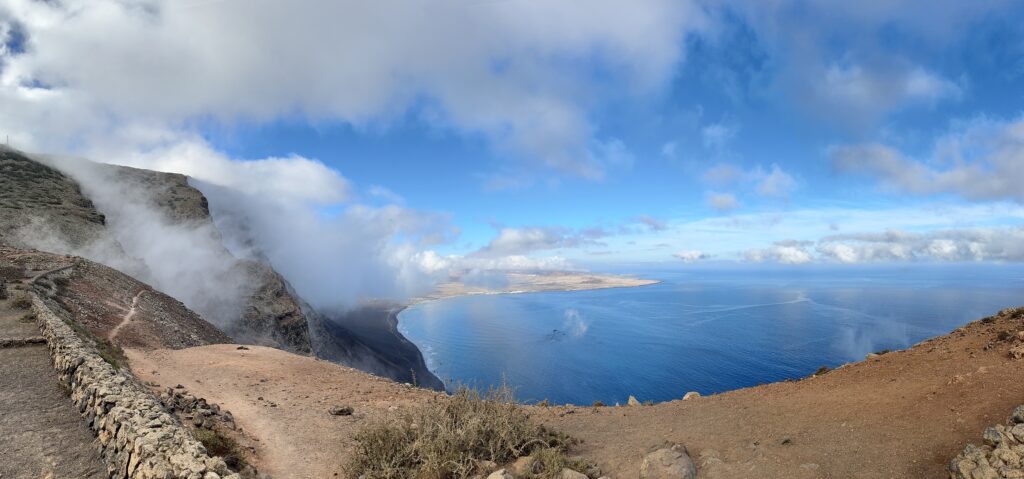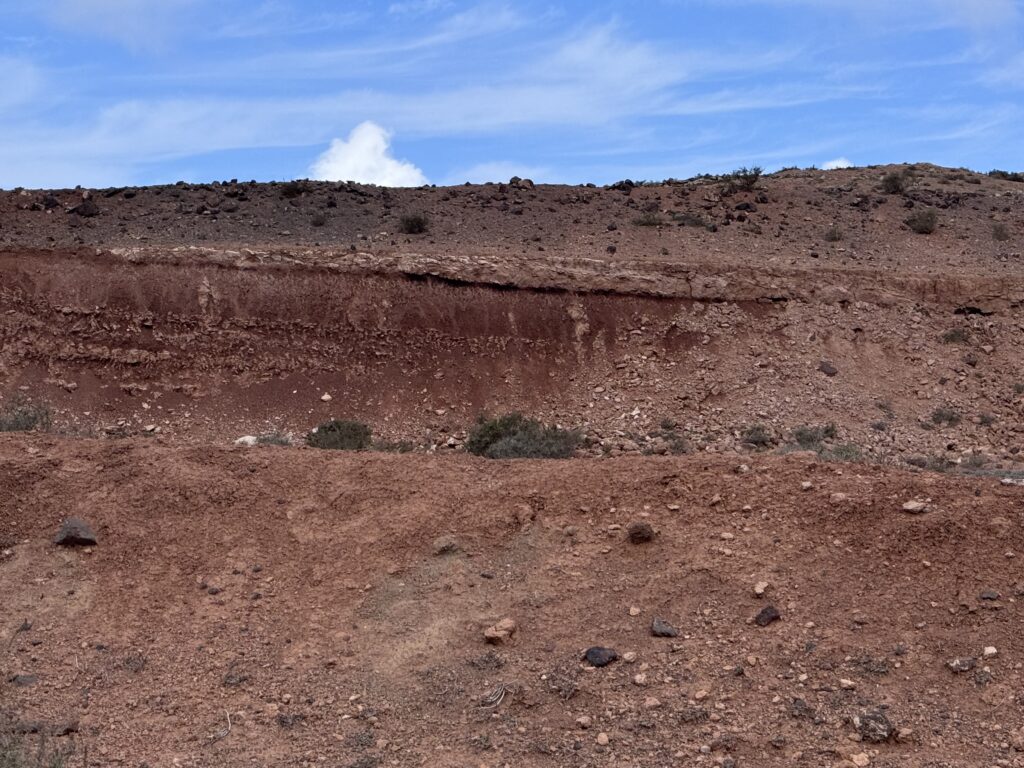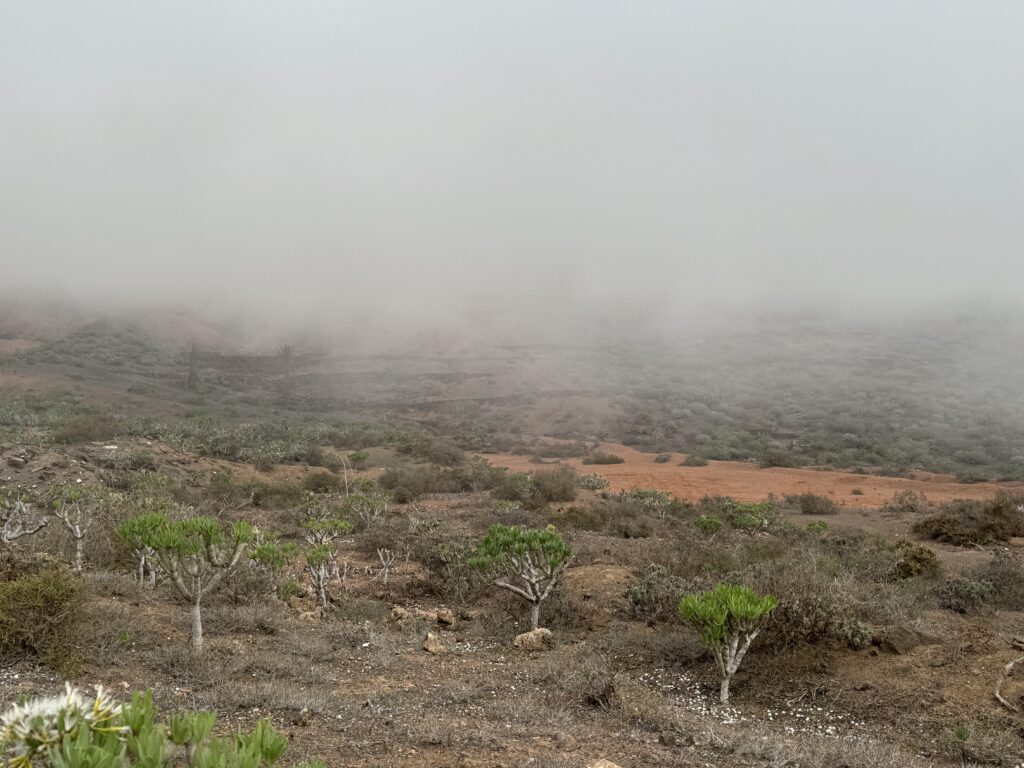Lanzarote is known for its year-round warm, sunny climate, and is indeed a true desert island when measured on the Köppen climate classification scale due to extremely low levels of precipitation. However, like most of the archipelago, if positioned favourably within the unique topography of each island, certain regions of high ground can become considerably foggy for long periods of time. One such place is Haría’s Mt. Aganada, where fog can accumulate for at least six months of the year. And where there are clouds, there can be forests.

Cloud Forests
They sound like something from the Lord of the Rings but these delicate ecosystems are very real and nearer than you might think. A cloud forest exists where rolling cloud passes over hilltops and, although little or no rain is deposited the tiny water droplets which form the cloud are intercepted by leaves and branches of the trees and drip down into the soil, watering roots. In Tenerife, for example, the pine forest intercepts cloud in this way, providing several times more ground water than the island gets from rainfall. The magnificent Tenerife forest is certainly not elfin, it forms a ring which does not reach the peak of Mt. Teide and is consequently protected from the worst of the wind. Elfin forests exist on hilltops and lack this protection, therefore trees tend to be stunted and bent by constant gales. Such a forest existed on the highest parts Haría district until a century or two ago, now only a handful of trees remain but the thickness of topsoil proves without doubt that such a forest existed there until fairly recently. There were no pines as these are not native to Lanzarote, but instead trees such as the Acebuche, a relative of the cultivated olive, formed a forest ecosystem known as Laurisilva . Despite its aridity Lanzarote may have more unique plants than any other Canary Island, most of which are native to this region, if trees could be re-established other native flora and fauna can be expected to follow, an ecosystem of great biological importance would be resurrected. A splendid goal in a century becoming increasingly characterised by wholesale destruction of such delicate ecosystems!


If you take a walk along Haría’s Mt. Aganada when cloud cover is present (take care not to get lost!) you will notice that the cloud hovers a metre or so above the ground – your hair gets damp while your legs remain dry. This illustrates the problem that reforestation schemes have so far met, until a tree grows big enough it cannot access water from passing clouds. Young trees have been planted in their thousands, most have dried up and died. A simple but effective method of nurturing treelings can be implemented. Placing large nets supported high above the ground and positioned so as to intercept passing clouds, liberates hundreds of litres of pure water used to feed tree roots until they grow tall enough to take over from the nets, effectively kick-starting development of a new forest. https://fogquest.org website (available in both English and Spanish) provides the most up-to-date guide to modern fog capturing projects and techniques.
I put together a project plan involving planting native trees using simple cloud catching nets on the sumit of Montaña Aganada, after seeking advice from Professor Schemenauer, a pioneer in this type of project, and also citing the work of Professor Victoria Marzol, from Tenerife’s University of La Laguna.
The project was submitted for funding to the Island Council in October 2003, by Haría council, and approved. The full project can be viewed here.
The pilot project ran successfully from the summer of 2004. Articles about the project were featured in the media.
A particularly strong tropical depression (Storm Delta) destroyed the nets in the winter of 2005. What followed was a political dispute, whereby the council accused me of plagiarism and took over the project. I was forbidden to participate in its future development, and tragically the council later abandoned the project. Twenty years on, there could now be a significant forest at Montaña Aganada, but the site remains a desert plateau. It continues to be cloaked with clouds, and occasionally heavily eroded by rains. It is a ghost forest, one of the imagination, waiting to be brought back to life.
A detailed review of the council takeover in Diario de Lanzarote in 2016 with English translation can be found here.
The letter below affirms my position as the original author of the project:
Me encantan los árboles y he pasado gran parte de los últimos 20 años cultivando algo de nuestra rara flora autóctona en mi jardín, por lo que estoy muy interesado en ver que el alcalde de Haría y su socio político Juan Manuel González no solo han implementado este proyecto sino que también han también lo presentó al departamento de Biosfera el 11 de agosto cuando ganó un premio por proyectos sostenibles.
Solo me molesta un problemita, como es esta obra, presentada como propia por Snr. González, ¿algo diferente a la propuesta que redacté a pedido del alcalde y le mostré en 2003? Mi propuesta original ha estado disponible desde entonces para que todos la vean en mi sitio web, harialanzarote.com. Al principio se reconocieron los años de trabajo que puse en el esquema, los informes periodísticos llamaron al esquema piloto 'Proyecto David'. Pero cuando comencé a hablar de fuentes de financiación para la fase 2 del proyecto Snr. González se volvió muy cauteloso y se negó a darme acceso a sus cuentas alegando que no tenía derecho a preguntar sobre las finanzas del esquema porque "no tenía nada que ver conmigo" de hecho, dijo, simplemente había plagiado el trabajo de otro científico. Si observa la propuesta en mi sitio web, puede ver que menciono a una científica canaria, la profesora Marzol, como una posible fuente de colaboración, de hecho, había estado en comunicación con ella muchos años antes, ya que tiene experiencia con la intercepción de nubes como fuente. de agua potable Me dice que está muy sorprendida de que la usen como excusa para retirar el proyecto de mi participación. Si de hecho le robaron mi trabajo, ¡parecería muy poco probable que la nombrara en mi propuesta!
La mía fue la primera propuesta de utilizar técnicas de captura de nubes para restaurar el bosque nuboso de Haria. De hecho, la tesis que describe el proyecto que preparé para mi maestría en silvicultura ambiental, está disponible en la biblioteca de la Universidad de Gales del Norte (¡o de mí!). parece ser la primera sugerencia de que las redes de captura de nubes desarrolladas recientemente en ese momento podrían usarse para la reforestación en lugar de solo beber agua. Escribí y acepté mi tesis en 1993, muchos años antes de que persuadiera al alcalde de que mi proyecto era factible y me pidió que preparara la propuesta del proyecto.
Durante mucho tiempo, el alcalde continuó dándome falsas garantías, cuando le pedí que confirmara que los años de estudio científico que había puesto en el proyecto no se desperdiciarían, pero quedó claro que la sugerencia de que le había robado el proyecto. El Prof. Marzol estaba circulando entre los concejales, así que preparé una copia de algunos documentos que probaban mi autoría original y dejé copias en el ayuntamiento para cada miembro del concejo. El alcalde impidió que se transmitieran y al mismo tiempo dejó de fingir simpatía por mi situación.
Poco después de esta decepción, una cadena de funcionarios comenzó a aparecer en mi casa diciendo que me había 'robado' un par de metros de baranco cuando reparé una pared y tuve que pagar miles de euros para arreglar las cosas. Todo el caso era ridículo y finalmente fue desestimado en los tribunales, pero no sin antes costarme mucho tiempo y preocupaciones. Por supuesto, es probable que sea ridículo sospechar que este problema fue una advertencia del alcalde para que no sacudiera el barco por su amigo. Pero cuando comparo el enorme problema de ese muro con la aparente ausencia total de acción sobre edificios enteros que brotan ilegalmente como hongos por todo Haria, no puedo evitar preguntarme si el alcalde no es capaz de usar su poder para tanto castigar como recompensar.
Dado que el alcalde ahora se niega a verme y JM ha roto su promesa de mantenerme informado de los acontecimientos, me gustaría presentarles la siguiente carta abierta a ambos;
JM, has robado descaradamente mi proyecto, fingiendo experiencia que te falta. Ha agregado insulto a la lesión al sugerir que no fue mi idea original en primer lugar. Si dice que "su" proyecto implica hacer algo importante además de seguir las instrucciones escritas en mi propuesta original, entonces es un mentiroso.
Sr alcalde, le confié mi proyecto como una colaboración. Lo ha tomado sin mi permiso usándolo para recompensar a su socio político, un antiguo vendedor de seguros que nunca había cultivado un árbol en su vida. Si obtiene el control de la Cueva y los Jameos como pretende, ¿será en beneficio de quienes han trabajado desinteresadamente en beneficio del distrito de Haría o solo de sus compañeros de Coalición Canarias? Es irónico que haya lanzado su carrera como alcalde con un ataque mordaz criticando la falta de honestidad de Snr. Ramírez, el anterior alcalde (ahora 'rehabilitado' como compañero de Coalición Canarias). Sea lo que sea de lo que Ramírez fue culpable, probablemente solo involucró dinero; sin embargo, me has robado años de mi vida.
